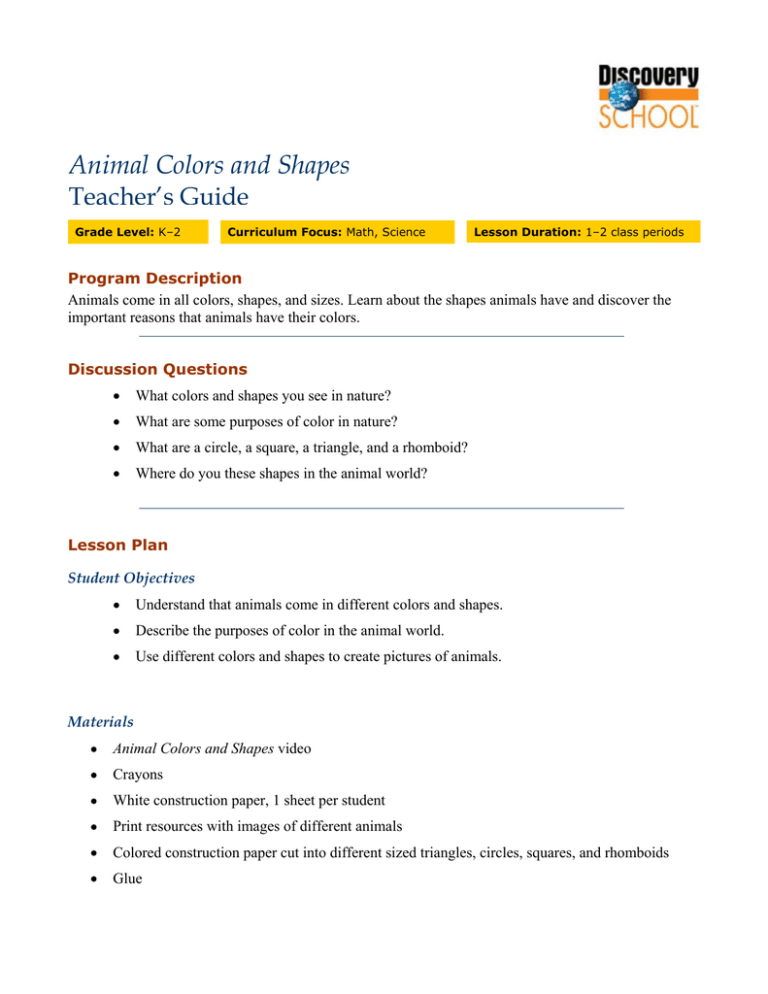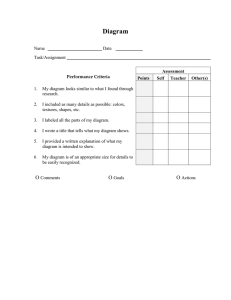
Animal Colors and Shapes
Teacher’s Guide
Grade Level: K–2
Curriculum Focus: Math, Science
Lesson Duration: 1–2 class periods
Program Description
Animals come in all colors, shapes, and sizes. Learn about the shapes animals have and discover the
important reasons that animals have their colors.
Discussion Questions
•
What colors and shapes you see in nature?
•
What are some purposes of color in nature?
•
What are a circle, a square, a triangle, and a rhomboid?
•
Where do you these shapes in the animal world?
Lesson Plan
Student Objectives
•
Understand that animals come in different colors and shapes.
•
Describe the purposes of color in the animal world.
•
Use different colors and shapes to create pictures of animals.
Materials
•
Animal Colors and Shapes video
•
Crayons
•
White construction paper, 1 sheet per student
•
Print resources with images of different animals
•
Colored construction paper cut into different sized triangles, circles, squares, and rhomboids
•
Glue
Animal Colors and Shapes
Teacher’s Guide
2
Procedures
1. Use Animals Colors and Shapes to introduce common colors and shapes in the animal world.
After watching the program, ask students to share examples shapes they have seen. What body
part of most animals is circular? What animals have triangles? What animals have rhomboids?
2. Talk about the students’ favorite animals. What colors can be found on them? Discuss some of
the purposes of color in the animal world. Why are the feathers on most male birds bright colors,
while female birds have gray or brown? How do some animals use color to stay hidden? Why are
some snakes brightly colored?
3. Share print images of animals. Talk about the different colors and shapes of these animals. Tell
students that they are going to create pictures of animals with different shapes. They will also
draw a picture of the animal’s habitat.
4. Demonstrate using a print image as an example. Talk about the animal. What kind of
environment would you expect to find this animal in? Have students describe where this animal
might live. Does it live in a desert or a forest? Using crayons, quickly draw the environment on a
piece of white construction paper. Next, talk about the different shapes students might see on the
animal. What shape are its ears? What shape is its body? Use different size construction-paper
shapes to create the animal. Arrange the shapes on the background habitat, being sure to tell
students that you will not use glue until it looks the way you want it to. Finally, glue the shapes
on the background habitat. Demonstrate using crayons to make additional lines that should
appear (such as whiskers) on the animal.
5. Making sure that students understand what they are supposed to do, give them print images of
animals and tell them to choose one to copy for their picture. Have them first draw the
background habitat and then use the paper shapes to make their animal. Check student work
before allowing them to glue their animal shapes to the background.
6. Once students have finished their pictures, ask volunteers to share them. Talk about the shapes
they used. Discuss the colors of the animals. Ask about the animals’ habitats. Does the color of
the animal help it blend into its habitat? Display the finished pictures in the classroom.
Assessment
Use the following three-point rubric to evaluate students’ work during this lesson.
•
3 points: Students were highly engaged in class discussions; were able to demonstrate a clear
understanding of the purposes of color in the animal world; and correctly used different
shapes to create unique and colorful pictures of animals that clearly identified where the
particular animal lives and accurately portrayed what it looks like.
•
2 points: Students participated in class discussions; were able to demonstrate a basic
understanding of the purposes of color in the animal world; and mostly used the correct
shapes to create somewhat unique and colorful pictures of animals that vaguely identified
where the particular animal lives and generally portrayed what it looks like.
•
1 point: Students participated minimally in class discussions; were unable to demonstrate a
basic understanding of the purposes of color in the animal world; and created incomplete
Published by Discovery Education. © 2005. All rights reserved.
Animal Colors and Shapes
Teacher’s Guide
3
pictures that did not clearly identify a particular animal and demonstrated a lack of
understanding about what shapes might identify the animal they had attempted to create.
Vocabulary
camouflage
Definition: The natural coloring or form of an animal that allows it to blend into its surroundings
Context: Colors that help an animal hide are called camouflage.
circle
Definition: A line that has no beginning or end, no sides or corners; perfectly round
Context: A fish eye is the shape of a circle.
colors
Definition: One, or any of the mixture, of the parts in which light can be separated
Context: Animals have more colors than there are in a rainbow.
rhomboid
Definition: A four-sided, four-cornered shape of which only the opposite sides and angles
are equal
Context: Some reptiles have rhomboid shapes on their bodies.
shape
Definition: The outward form of something as created by its outline
Context: Every object—living and nonliving—has many shapes.
square
Definition: A shape that has four sides and four corners; every side is the same length.
Context: A giraffe’s spots can be in the shape of a square.
triangle
Definition: A shape that has three sides and three corners
Context: A rhinoceros horn is a triangle because it has three sides.
Academic Standards
National Academy of Sciences
The National Academy of Sciences provides guidelines for teaching science in grades K–12 to
promote scientific literacy. To view the standards, visit this Web site:
http://books.nap.edu/html/nses/html/overview.html#content.
Published by Discovery Education. © 2005. All rights reserved.
Animal Colors and Shapes
Teacher’s Guide
4
This lesson plan addresses the following science standards:
•
Life Science: Organisms and environments
Mid-continent Research for Education and Learning (McREL)
McREL’s Content Knowledge: A Compendium of Standards and Benchmarks for K-12 Education
addresses 14 content areas. To view the standards and benchmarks, visit
http://www.mcrel.org/compendium/browse.asp
This lesson plan addresses the following national standards:
•
Language Arts—Viewing: Uses viewing skills and strategies to understand and interpret
visual media: Understands the main idea or message in visual media (e.g., pictures, cartoons,
weather reports on television, newspaper photographs, visual narratives)
•
Art—Art Connections: Understands connections among the various art forms and other
disciplines; Knows how various concepts and principles are used in the arts and disciplines
outside the arts (e.g., balance, shape, and pattern)
•
Science—Life Science: Understands relationships among organisms and their physical
environment
DVD Content
This program is available in an interactive DVD format. The following information and activities are
specific to the DVD version.
How to Use the DVD
The DVD starting screen has the following options:
Play Video—This plays the video from start to finish. There are no programmed stops, except by
using a remote control. With a computer, depending on the particular software player, a pause
button is included with the other video controls.
Video Index—Here the video is divided into sections (see below), indicated by video thumbnail
icons. Watching all parts in sequence is similar to watching the video from start to finish. Brief
descriptions and total running times are noted for each part. To play a particular segment, press
Enter on the remote for TV playback; on a computer, click once to highlight a thumbnail and read
the accompanying text description and click again to start the video.
Standards Link—Selecting this option displays a single screen that lists the national academic
standards the video addresses.
Teacher Resources—This screen gives the technical support number and Web site address.
Published by Discovery Education. © 2005. All rights reserved.
Animal Colors and Shapes
Teacher’s Guide
5
Video Index
Segment 1. Introduction to Colors and Shapes
Take a tour of the colors and shapes in the animal kingdom.
Discussion question
Q: What colors and shapes would you use to describe your favorite kind of animal?
A: Answers will vary.
Segment 2. Animal Colors
Learn about the purposes of the many colors in the animal world.
Discussion question
Q: Why do animals have colors on their bodies?
A: The color of an animal can help it stay out of danger, find food, or find a mate.
Segment 3. Warning Colors
Some snakes, frogs, and butterflies have colors that warn others to stay away.
Discussion question
Q: Are warning colors a good way for animals to protect themselves?
A: Answers will vary.
Segment 4. Camouflage Colors
Camouflage can give animals protection from predators.
Discussion question
Q: What colors give animals camouflage?
A: Green, gray, and brown are common in nature so they are good camouflage colors. And white
is a good camouflage color in the icy arctic environment.
Segment 5. Changing Colors
Take a closer look at the African chameleon and other animals that can change their body colors.
Discussion question
Q: Why is it useful for an animal to change body color?
A: Answers will vary.
Segment 6. Show-Off Colors
Discover why male birds often have bright and bold feathers and females have dull brown
or gray.
Discussion question
Q: Why do male birds often have bright and bold colors? Why do female birds have duller
Published by Discovery Education. © 2005. All rights reserved.
Animal Colors and Shapes
Teacher’s Guide
colors?
A: Male birds use bright colors to attract females. Female birds often have duller colors so they
can blend into their environment and better their young.
Segment 7. Animal Shapes
Tour the animal kingdom to find shapes in the animals around you.
Discussion question
Q: What shapes have you seen in the animal kingdom?
A: Answers will vary.
Segment 8. Lines
Take a closer look at the lines that appear in animals of all shapes and sizes.
Discussion question
Q: What animals do you think have the most lines?
A: Answers will vary.
Segment 9. Circles
See a few of the many examples of natural circles in animals.
Discussion question
Q: What examples of circles have you seen in animals?
A: Answers will vary.
Segment 10. Triangles
See examples of triangles that appear naturally in the animal world.
Discussion question
Q: What animals have triangle shapes on their bodies?
A: Answers will vary.
Segment 11. Squares
Not as common as circles, squares are found in many animals.
Discussion question
Q: Where have you seen squares in nature?
A: Answers will vary.
Segment 12. Rhomboids
Take a look at some animals that have rhomboids on their bodies.
Discussion question
Q: What is the difference between a rhomboid and a square?
A: Both rhomboids and squares have four sides and four corners, but a square looks like two
Published by Discovery Education. © 2005. All rights reserved.
6
Animal Colors and Shapes
Teacher’s Guide
rectangles together, and a rhomboid looks like two triangles together. Some people call
a rhomboid a diamond.
Support Materials
Develop custom worksheets, educational puzzles, online quizzes, and more with the free teaching tools
offered on the Discoveryschool.com Web site. Create and print support materials, or save them to a
Custom Classroom account for future use. To learn more, visit
•
http://school.discovery.com/teachingtools/teachingtools.html
Published by Discovery Education. © 2005. All rights reserved.
7



